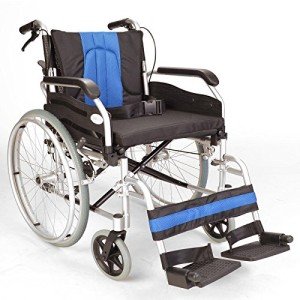Bariatric Folding Wheelchair
Bariatric folding wheelchairs are developed to accommodate users of a bigger size. They include a higher weight capacity than standard designs and are developed with reinforced products for added stability and durability.
Nevertheless, not everyone with a high body mass index (BMI) needs a bariatric chair as numerous fall within the safe weight limits of basic wheelchairs.
Size and Weight Capacity
Bariatric wheelchairs have broader seats and are designed to accommodate bigger individuals, typically weighing as much as 500 pounds. These chairs have a durable frame made from reinforced materials like steel and are constructed with larger wheels that supply more weight circulation and maneuverability for larger users.
When comparing bariatric wheelchairs, ensure the weight capacity is noted as static or active load. Static weight capacity refers to just how much a chair can hold when it's sitting still, while active load capacity is figured out by putting the chair through a drop test that mimics somebody plopping down into the seat.
Standard wheelchairs are widely produced and designed for users with typical body weights, making them more affordable than bariatric models. Medicare and other insurance coverages might only cover a restricted variety of bariatric wheelchairs, depending on a client's medical requirements and diagnosis. bariatric aids are also more costly than standard wheelchairs due to the fact that they have a specialized style and building. However, they are a terrific option for clients with a broad variety of medical conditions that need a more comfortable travel experience.
Seat Dimensions and Comfort
Unlike basic wheelchairs, bariatric designs have broader seats to accommodate larger people. They likewise have more robust frames and big, long lasting wheels that can stand up to higher loads. They can be tailored with various seating alternatives and accessories based on the user's requirements and preferences.
When comparing wheelchairs, it's important to look at their weight capabilities under both static and active load rankings. Static load describes the chair's optimum capacity when it's sitting still, while active load procedures how much a wheelchair can securely hold when somebody sits in it and moves around. Some makers might likewise show the weight limit of a bariatric wheelchair in kgs, which is often more accurate because it considers the average bodyweight of a person who uses the chair.
In addition to a broad seat, a bariatric folding wheelchair must have adjustable cushioned leg rests to assist users remain comfortable while taking a trip. It ought to also have flip up armrests that can be moved out of the way to avoid getting in the user's method when they wish to stand or move to another surface area.
If you're considering a bariatric wheelchair, ask a doctor or mobility specialist for recommendations. They can examine your needs, advise the best chairs for you, and guide you through the procedure of buying one. They can also assist you compare functions and costs to find a wheelchair that best fits your spending plan. They can even provide advice on other mobility options such as power placing systems and iLevel seating.
Weight and Portability
While basic wheelchairs are usually affordable, bariatric chairs tend to be a bit more expensive. This is due to their specialized style and construction, as well as the fact that they're a little much heavier than their counterparts.

If you're concerned about the cost of a bariatric chair, talk with a doctor or mobility professional. They'll be able to evaluate your distinct requirements and figure out which type of wheelchair is the finest fit for you. They can also recommend wheelchair accessories based on your specific requirements. In addition, if you're aiming to get your wheelchair covered by insurance coverage, such as Medi-Cal, they can guide you on the steps involved in this process. To learn more, read our guide to wheelchair insurance coverage. Then, you can begin your journey towards independent mobility.
Manoeuvrability and Handling
Picking the ideal wheelchair can be an essential decision for those with minimal mobility. Bariatric wheelchairs offer increased weight capacities and are designed to accommodate larger individuals. They typically include larger wheels, larger armrests and seating choices, and are stronger than basic wheelchairs.
When choosing a bariatric wheelchair, consider the person's specific needs and the environment in which they will be utilizing it. Examine the weight capacity and seat dimensions, and search for adjustable functions like cushioned elevating leg rests to support comfort and ease of transfer.
Determine whether the wheelchair appropriates for manual or powered usage. For added versatility, a bariatric folding wheelchair can be quickly folded and compacted for storage or transport. This makes them an ideal option for those with restricted home area or who require to travel long distances. The wheelchairs also include leak evidence wheels to guarantee sturdiness and low upkeep. Suitable for users as much as a maximum of 35 stone.
